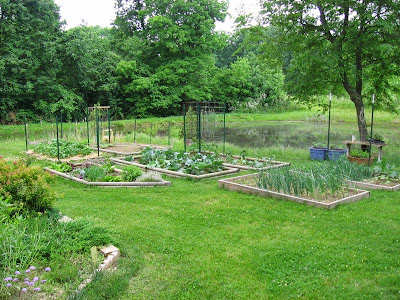Most of the structures that I use in the garden allow the plants to make use of vertical space. If the growing area has limits it can always be expanded upward as long as the soil has sufficient nutrition to support the higher density of plants. This morning I finished installing the last of the support structures in the beds and it seems like a good time to show these.
Everybody has their own methods. The supports I like to use are steel fence posts driven into the bed soil or just outside the raised bed. I've found that a properly sized post that is driven until its flange is completely in the ground will hold up to any weather excluding a tornado. They can be hard to pull up in the fall but a few soakings with the garden hose around the base will always loosen them.
In an earlier post I showed the suspended tomato cages and I'll show them again here. This year I'm growing three varieties in three cages. That may not sound like much but if the weather is not insane like last year it's not unreasonable to expect a hundred pounds of tomatoes from these three plants (Supersonic, Cherokee Purple and San Marzano). To make the cages I drove 7 foot steel posts, the rolled steel kind that have hooks, about a foot into the soil. The cages, made from 4' x 8' rebar mesh, were hung on the post hooks so the bottom of the cage is about 2 feet off the soil, making a cage about 6 feet high.
It's a little hard to see but there are three adjoining cages in the picture. The cages are supported by four posts and wired together where they touch. This makes for a very solid structure. Until the tomato plants have grown into the cages they are supported with a few bamboo stakes to guide them.
This morning I put up the cucumber trellis. The plants had grown to the point where they needed support quickly. Along the back of the bed I drove three 8 foot steel T-posts about 4 feet apart. These posts were driven just outside of the raised bed to avoid disturbing the soil in the bed, which has a lot of established plants. A 4' x 8' piece of rebar mesh was "hung" even with the top of the poles using T-post clips, about 6 feet above the bed soil.
With a good twist of one end of the clip with a needlenose plier the clip holds the mesh to the post very solidly. I used three clips on each post. I filled the open space at the bottom with pieces from those folding tomato cages you see in the stores. The cukes now have about 50 square feet of trellis space to expand into.
Potatoes always fall down about midsummer and I think this just invites disease in when the air circulation through the plants is poor. I like to give them some support for when they get bigger. This year I drove four 6' posts at each corner of the bed. Since they are driven over a foot into the soil I should be able to string wire or string tautly between the posts to help support the plants.
The potato box is an experiment. This morning I added another row of siding and directed more shoots out through a hole at the bottom of the siding, then added more leaf mold to cover most of the shoots inside. If this works there's a lot of design changes that must be made to this but for this season it's good enough. The back side faces north so there's no shoots growing out that side.
This is the pole bean tower. It goes into the sharp angle of the trapezoidal bed so I made it triangular in shape using three 6' fence posts. The wood crosspieces were connected to the posts with short drywall screws through the holes in the posts. A cordless screwdriver is a really handy tool to have in the garden for jobs like this. Some of the wood pieces were attached to the post and some were attached to other wood pieces - whatever works. I drilled holes in the top crosspieces and tied off garden twine from the top to bottom pieces. Nothing fancy, it's just the easiest design I could come up with using materials on hand.
Here's a panorama of sorts showing the completed structures in the vegetable garden.







2 comments:
I love these ideas. You are very ingenious, and the plants will thank you for it! I expect it won't be long before the "hardware" disappears in a mass of foliage. I see you have a big pond in your garden. Do you treat this as a water source, or is it for ornamental purposes?
Mark, I use an electric pump to water the beds from the pond, although it hasn't been needed yet with the spring rains. The pond also has a good population of channel catfish that supply a fish dinner about once a week. It's also a good wildlife habitat and pleasant place to be.
Post a Comment